What is Cholesterol?
Blue indicates link
Cholesterol is a waxy substance found in your blood. Your body needs cholesterol to build healthy cells, but high levels of cholesterol can increase your risk of heart disease.
Cholesterol is an organic molecule. It is a sterol, a type of lipid. Cholesterol is biosynthesized by all animal cells and is an essential structural component of animal cell membranes.
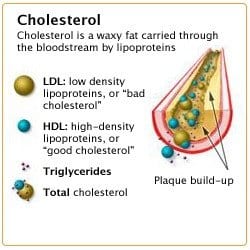 With high cholesterol, you can develop fatty deposits in your blood vessels. Eventually, these deposits grow, making it difficult for enough blood to flow through your arteries. Sometimes, those deposits can break suddenly and form a clot that causes a heart attack or stroke.
With high cholesterol, you can develop fatty deposits in your blood vessels. Eventually, these deposits grow, making it difficult for enough blood to flow through your arteries. Sometimes, those deposits can break suddenly and form a clot that causes a heart attack or stroke.
High cholesterol can be inherited, but it’s often the result of unhealthy lifestyle choices, which make it preventable and treatable. A healthy diet, regular exercise, and sometimes medication can help reduce high cholesterol.
Cholesterol Management
Cholesterol is carried through your blood, attached to proteins. This combination of proteins and cholesterol is called a lipoprotein. There are different types of cholesterol, based on what the lipoprotein carries. They are:
- Low-density lipoprotein (LDL). LDL, or “bad” cholesterol, transports cholesterol particles throughout your body. LDL cholesterol builds up in the walls of your arteries, making them hard and narrow.
- High-density lipoprotein (HDL). HDL, or “good” cholesterol, picks up excess cholesterol and takes it back to your liver.
A lipid profile also typically measures triglycerides, a type of fat in the blood. Having a high triglyceride level can also increase your risk of heart disease.
Factors you can control — such as inactivity, obesity, and an unhealthy diet — contribute to high cholesterol and low HDL cholesterol. Factors beyond your control might play a role, too. For example, your genetic makeup might keep cells from removing LDL cholesterol from your blood efficiently or cause your liver to produce too much cholesterol.
Risk factors:
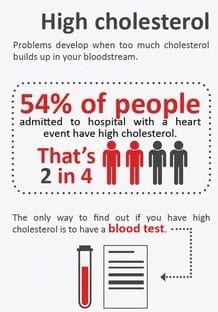
Factors that can increase your risk of bad cholesterol include:
- Poor diet. Eating saturated fat, found in animal products, and trans fats, found in some commercially baked cookies and crackers and microwave popcorn, can raise your cholesterol level. Foods that are high in cholesterol, such as red meat and full-fat dairy products, will also increase your cholesterol.
- Obesity. Having a body mass index (BMI) of 30 or greater puts you at risk of high cholesterol.
- Lack of exercise. Exercise helps boost your body’s HDL, or “good,” cholesterol while increasing the size of the particles that make up your LDL, or “bad,” cholesterol, which makes it less harmful.
- Smoking. Cigarette smoking damages the walls of your blood vessels, making them more prone to accumulate fatty deposits. Smoking might also lower your level of HDL, or “good,” cholesterol.
- Age. Because your body’s chemistry changes as you age, your risk of high cholesterol climbs. For instance, as you age, your liver becomes less able to remove LDL cholesterol.
- Diabetes. High blood sugar contributes to higher levels of dangerous cholesterol called very-low-density lipoprotein (VLDL) and lower HDL cholesterol. High blood sugar also damages the lining of your arteries.
Complications:
Development of atherosclerosis
High cholesterol can cause a dangerous accumulation of cholesterol and other deposits on the walls of your arteries (atherosclerosis). These deposits (plaques) can reduce blood flow through your arteries, which can cause complications, such as:
- Chest pain. If the arteries that supply your heart with blood (coronary arteries) are affected, you might have chest pain (angina) and other symptoms of coronary artery disease.
- Heart attack. If plaques tear or rupture, a blood clot can form at the plaque-rupture site — blocking the flow of blood or breaking free and plugging an artery downstream. If blood flow to part of your heart stops, you’ll have a heart attack.
- Stroke. Similar to a heart attack, a stroke occurs when a blood clot blocks blood flow to part of your brain.
Prevention:
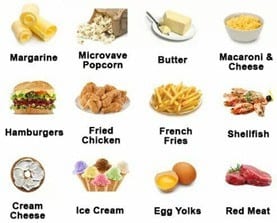
Foods to Avoid
The same heart-healthy lifestyle changes that can lower your cholesterol can help prevent you from having high cholesterol in the first place.
To help prevent high cholesterol, you can:
Eat a low-salt diet that emphasizes fruits, vegetables, and whole grains
Limit the number of animal fats and use good fats in moderation
Lose extra pounds and maintain a healthy weight
Exercise on most days of the week for at least 30 minutes
Drink alcohol in moderation, if at all
Manage stress
Diagnosis:
A blood test to check cholesterol levels — called a lipid panel or lipid profile — typically reports:
- Total cholesterol
- LDL cholesterol
- HDL cholesterol
- Triglycerides — a type of fat in the blood
For the most accurate measurements, don’t eat or drink anything (other than water) for nine to 12 hours before the blood sample is taken.
Interpreting the numbers:
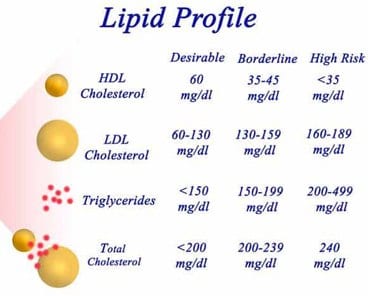
(Canada and most of Europe)Results*Canadian and European guidelines differ slightly from U.S. guidelines. These conversions are based on U.S. guidelines.
Children and cholesterol testing:
For most children, the National Heart, Lung, and Blood Institute recommends one cholesterol screening test between the ages of 9 and 11 and another cholesterol screening test between the ages of 17 and 21.
If your child has a family history of early-onset heart disease or a personal history of obesity or diabetes, your doctor might recommend earlier or more frequent cholesterol testing.
Treatment:
Lifestyle changes such as exercising and eating a healthy diet are the first line of defense against high cholesterol. But, if you’ve made these important lifestyle changes and your cholesterol levels remain high, your doctor might recommend medication.
The choice of medication or combination of medications depends on various factors, including your personal risk factors, your age, your health, and possible drug side effects. Common choices include:
- Statins block a substance your liver needs to make cholesterol. This causes your liver to remove cholesterol from your blood. Statins can also help your body reabsorb cholesterol from built-up deposits on your artery walls, potentially reversing coronary artery disease. Choices include atorvastatin (Lipitor), fluvastatin (Lescol XL), lovastatin (Altoprev), pitavastatin (Livalo), pravastatin (Pravachol), rosuvastatin (Crestor), and simvastatin (Zocor).
- Bile-acid-binding resins. Your liver uses cholesterol to make bile acids, a substance needed for digestion. The medications cholestyramine (Prevalite), colesevelam (Welchol), and colestipol (Colestid) lower cholesterol indirectly by binding to bile acids. This prompts your liver to use excess cholesterol to make more bile acids, which reduces the level of cholesterol in your blood.
- Cholesterol absorption inhibitors. Your small intestine absorbs the cholesterol from your diet and releases it into your bloodstream. The drug ezetimibe (Zetia) helps reduce blood cholesterol by limiting the absorption of dietary cholesterol. Ezetimibe can be used with a statin drug.
- Injectable medications. A newer class of drugs, known as PCSK9 inhibitors, can help the liver absorb more LDL cholesterol — which lowers the amount of cholesterol circulating in your blood. Alirocumab (Praluent) and evolocumab (Repatha) might be used for people who have a genetic condition that causes very high levels of LDL or in people with a history of coronary disease who have an intolerance to statins or other cholesterol medications.
Medications for high triglycerides:
If you also have high triglycerides, your doctor might prescribe:
- Fibrates. The medications fenofibrate (TriCor, Fenoglide, others) and gemfibrozil (Lopid) reduce your liver’s production of very-low-density lipoprotein (VLDL) cholesterol and speed the removal of triglycerides from your blood. VLDL cholesterol contains mostly triglycerides. Using fibrates with a stain can increase the risk of statin side effects.
- Niacin. Niacin limits your liver’s ability to produce LDL and VLDL cholesterol. But niacin doesn’t provide additional benefits over statins. Niacin has also been linked to liver damage and strokes, so most doctors now recommend it only for people who can’t take statins.
- Omega-3 fatty acid supplements. Omega-3 fatty acid supplements can help lower your triglycerides. They are available by prescription or over-the-counter. If you choose to take over-the-counter supplements, get your doctor’s OK. Omega-3 fatty acid supplements could affect other medications you’re taking.
Tolerance varies:
The tolerance of medications varies from person to person. The common side effects of statins are muscle pains and muscle damage, reversible memory loss and confusion, and elevated blood sugar. If you decide to take cholesterol medication, your doctor might recommend liver function tests to monitor the medication’s effect on your liver.
Children and cholesterol treatment:
Diet and exercise are the best initial treatment for children age 2 and older who have high cholesterol or who are obese. Children age 10 and older who have extremely high cholesterol levels might be prescribed cholesterol-lowering drugs, such as statins.
Lifestyle and home remedies:
Lifestyle changes are essential to improve your cholesterol levels. To bring your numbers down, try the following:
- Lose extra pounds. Losing even 5 to 10 pounds can help lower cholesterol levels.
- Eat a heart-healthy diet. Focus on plant-based foods, including fruits, vegetables, and whole grains. Limit saturated fats, found in red meat and full-fat dairy products, and trans fats, found in many processed foods. Monounsaturated fat — found in olive and canola oils — is a healthier option. Avocados, nuts, and oily fish are other sources of healthy fat.
- Exercise regularly. With your doctor’s OK, work up to at least 30 minutes of moderate-intensity exercise five times a week or vigorous exercise five times a week.
- Don’t smoke. If you smoke, find a way to quit.
Alternative medicine:
Few natural products have been proven to reduce cholesterol, but some might be helpful. With your doctor’s OK, consider these cholesterol-lowering supplements and products:
- Barley
- Plant sterols and stanols, found in oral supplements, some fortified orange juices, and some kinds of margarine, such as Promise Active
- Blond psyllium, found in seed husk and products such as Metamucil
- Oat bran, found in oatmeal and whole oats
Another popular cholesterol-lowering supplement is red yeast rice. There is evidence that red yeast rice can help lower your LDL cholesterol. However, the Food and Drug Administration has said that red yeast rice products that contain monacolin K, a naturally occurring form of the prescription medication known as lovastatin, can’t be sold in the United States.
If you buy red yeast rice supplements in the United States, there’s no way to know whether you’re getting enough monacolin K to lower your LDL cholesterol. In other countries, lovastatin in red yeast rice products is potentially dangerous because there’s no way to know how much might be in a particular product or what the quality of the lovastatin is.
Even if you take cholesterol-lowering supplements, remember the importance of a healthy lifestyle, and take medication to reduce your cholesterol as directed. Tell your doctor which supplements you take.
Understanding Cholesterol Numbers:
Cholesterol levels should be measured at least once every five years in everyone over age 20. The screening test that is usually performed is a blood test called a lipid profile. Experts recommend that men ages 35 and older and women ages 45 and older be more frequently screened for lipid disorders. The lipoprotein profile includes:
- Total cholesterol
- LDL (low-density lipoprotein cholesterol, also called “bad” cholesterol)
- HDL (high-density lipoprotein cholesterol, also called “good” cholesterol)
- Triglycerides (fats carried in the blood from the food we eat. Excess calories, alcohol, or sugar in the body are converted into triglycerides and stored in fat cells throughout the body.)
The results of your blood test will come in the form of numbers. Here is how to interpret your cholesterol numbers. The first thing you need to know is that the numbers by themselves are not enough to predict your risk of heart problems or to determine what you need to do to lower that risk. They are, instead, one part of a larger equation that includes your age, your blood pressure, your smoking status, and your use of blood pressure medicines. Your doctor will use this information to calculate your 10-year risk for serious heart problems. Then the two of you will develop a strategy for reducing that risk.
LDL Cholesterol:
LDL cholesterol can build up on the walls of your arteries and increase your chances of getting heart disease. That is why LDL cholesterol is referred to as “bad” cholesterol. The lower your LDL cholesterol number, the lower your risk.
If your LDL is 190 or more, it is considered very high. Your doctor will most likely recommend a statin in addition to making healthy lifestyle choices. Statins are medicines that can help lower cholesterol levels.
You may also need to take a statin even though your LDL level is lower than 190. After figuring out your 10-year risk, your doctor will recommend a percentage by which you should try to lower your LDL level through diet, exercise, and medication if necessary.
HDL Cholesterol:
When it comes to HDL cholesterol — “good” cholesterol – a higher number means lower risk. This is because HDL cholesterol protects against heart disease by taking the “bad” cholesterol out of your blood and keeping it from building up in your arteries. A statin can slightly increase your HDL, as can exercise.
Triglycerides:
Triglycerides are the form in which most fat exists in food and the body. A high triglyceride level has been linked to a higher risk of coronary artery disease. Here’s the breakdown.
TriglyceridesTriglyceride Category. Less than 150Normal150 – 199Mildly High200 – 499High500 or higher
Total Cholesterol:
Your total blood cholesterol is a measure of LDL cholesterol, HDL cholesterol, and other lipid components. Your doctor will use your total cholesterol number when determining your risk for heart disease and how best to manage it.
What should my cholesterol level be at my age?
Cholesterol levels vary by age, weight, and gender. Over time, a person’s body tends to produce more cholesterol, meaning that all adults should check their cholesterol levels regularly, ideally about every 4 to 6 years.
Cholesterol is measured in three categories:
- Total cholesterol
- LDL, or ‘bad cholesterol”
- HDL, or ‘good cholesterol”
The struggle for most people is balancing these levels. While total and LDL cholesterol levels should be kept low, having more HDL cholesterol can offer some protection against a person developing heart-related illnesses including heart attacks and strokes.
Cholesterol levels and age:
Balancing cholesterol in early life is important as unmanaged cholesterol in later life is difficult to treat.
Cholesterol levels tend to increase with age. Doctors recommend taking steps earlier in life to prevent dangerously high levels of cholesterol from developing as a person ages. Years of unmanaged cholesterol can be much trickier to treat.
Children are least likely to have high levels of cholesterol and only need to have their levels checked once or twice before they are 18 years old.
However, if the child has risk factors for higher levels of cholesterol, they should be monitored more frequently.
Typically, men tend to have higher levels of cholesterol throughout life than women. A man’s cholesterol levels generally increase as they age. However, women aren’t immune to high cholesterol. A woman’s cholesterol often increases when she goes through menopause.
Cholesterol levels for adults:
- Total cholesterol levels less than 200 milligrams per deciliter (mg/dL) are considered desirable for adults. A reading between 200 and 239 mg/dL is considered borderline high and a reading of 240 mg/dL and above is considered high.
- LDL cholesterol levels should be less than 100 mg/dL. Levels of 100 to 129 mg/dL are acceptable for people with no health issues but may be of more concern for those with heart disease or heart disease risk factors. A reading of 130 to 159 mg/dL is borderline high and 160 to 189 mg/dL is high. A reading of 190 mg/dL or higher is considered very high.
- HDL levels should be kept higher. A reading of less than 40 mg/dL is considered a major risk factor for heart disease. A reading from 41 mg/dL to 59 mg/dL is considered borderline low. The optimal reading for HDL levels is 60 mg/dL or higher.
Cholesterol levels for children:
By comparison, acceptable levels of total cholesterol and LDL cholesterol in children are different.
- An acceptable range of total cholesterol for a child is less than 170 mg/dL. Borderline high total cholesterol for a child ranges from 170 to 199 mg/dL. Any reading of total cholesterol over 200 in a child is too high.
- A child’s LDL cholesterol levels should also be lower than an adult’s. The optimal range of LDL cholesterol for a child is less than 110 mg/dL. Borderline high is from 110 to 129 mg/dL while high is over 130 mg/dL.
Tips:

For children and adults, eating a healthy diet and taking regular exercise will help to keep cholesterol levels in check.
The best recommendation for children and adolescents to keep cholesterol levels in check is to live a healthy, active lifestyle. This includes eating a healthy diet and getting plenty of exercise.
Sedentary, overweight children who eat a diet high in processed foods are most likely to have high cholesterol. Children who have a family history of high cholesterol may also be at risk.
Generally, the earlier an adult starts living a healthy lifestyle, the better for their cholesterol levels. Cholesterol levels build over time. A sudden change in lifestyle will help eventually, but the older a person is, the less impact they will see in cholesterol levels.
All adults should stay active and maintain regular exercise routines. Women going through menopause and adults with high levels of cholesterol may want to consider medication that will help reduce cholesterol levels more rapidly than diet alone.
High cholesterol at any age puts a person at risk for heart disease, heart attack, and strokes. These risks only increase over time, especially for adults who are not taking action to reduce their cholesterol buildup.
Treatment options:
Doctors may prescribe statins to help lower cholesterol.
There are methods people can use to reduce cholesterol levels and prevent them from increasing. One potential method is using therapeutic lifestyle changes (TLC), which include diet, exercise, and weight management. Another option is drug therapies that either lower cholesterol or reduce the absorption of cholesterol.
At any age, diets low in saturated fats and trans fats and high in soluble fibers and protein are good for lowering cholesterol buildup.
The TLC diet is a low-saturated-fat, low-cholesterol eating plan. People following it should have a daily intake of less than 7 percent of calories from saturated fat and less than 200 milligrams of dietary cholesterol.
The TLC diet encourages people to eat the following foods:
- fruits
- vegetables
- whole grains
- low-fat or nonfat dairy products
- fish
- skinless poultry
- lean meats
Additionally, the TLC diet suggests only taking in enough calories to maintain a desirable weight and avoid weight gain. Increasing the intake of soluble fibers and food that contains naturally occurring substances, such as some kinds of margarine, can also boost the diet’s LDL-lowering power.
Proper weight management is another essential part of lowering cholesterol and preventing it from building up. Overweight people who reduce their weight can help lower LDL in the process.
Losing weight is especially important for those with a group of risk factors that include:
- high triglyceride levels
- low HDL levels
- overweight men with a waist measurement of more than 40 inches
- overweight women with a waist measurement of more than 35 inches
Regular physical activity of 30 minutes on most days is recommended for everyone. This will also help with weight management, which in turn helps with lowering cholesterol.
When these steps are not enough, drug treatment may also be needed.
There are several types of cholesterol-lowering drugs available, including:
- Statins. These drugs block the liver from producing cholesterol.
- Bile acid sequestrants. These drugs reduce the amount of fat absorbed from food.
- Cholesterol absorption inhibitors. These drugs lower triglycerides in the blood and reduce the amount of cholesterol absorbed from food.
- Some vitamins and supplements, such as Niacin, available online, stop the liver from removing HDL and lower triglycerides.
- Omega-3 fatty acids. These acids raise the level of HDL and lower triglycerides. There is a range of Omega-3 fatty acids available online.
The best treatment to lower cholesterol levels involves a range of different methods, including lifestyle and diet. Ultimately, a doctor is the best person to talk to in order to figure out the best way for a person to lower bad cholesterol levels.
11 High-Cholesterol Foods — Which to Eat, Which to Avoid:
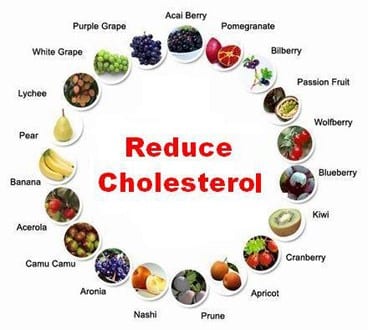
Cholesterol-Lowering Foods
Cholesterol is arguably one of the most misunderstood substances.
For decades, people avoided healthy yet cholesterol-rich foods like eggs due to the fear that these foods would increase their risk of heart disease.
However, recent research shows that — for most people — consuming healthy foods that are high in cholesterol won’t harm your health.
What’s more, some cholesterol-rich foods are loaded with important nutrients that are lacking in many people’s diets.
This article explains why cholesterol in foods should not be feared and lists healthy high-cholesterol foods and some that should be avoided.
Your liver produces all of the cholesterol that your body needs to function, but cholesterol can also be introduced through the consumption of animal products.
Since cholesterol doesn’t mix well with liquids (blood), it’s transported by particles called lipoproteins, including low-density and high-density lipoprotein — or LDL and HDL.
LDL is often referred to as “bad cholesterol,” as it’s associated with plaque buildup in arteries, while HDL (“good cholesterol”) helps excrete excess cholesterol from your body.
When you consume extra cholesterol, your body compensates by reducing the amount of cholesterol that it naturally makes.
In contrast, when dietary cholesterol intake is low, your body increases cholesterol production to ensure there is always enough of this vital substance.
Only about 25% of the cholesterol in your system comes from dietary sources. The rest is produced by your liver.
Is Dietary Cholesterol Harmful?
Research has shown that dietary cholesterol does not significantly impact cholesterol levels in your body, and data from population studies do not support an association between dietary cholesterol and heart disease in the general population.
Though dietary cholesterol can slightly impact cholesterol levels, this isn’t an issue for most people.
In fact, two-thirds of the world’s population experience little or no increase in cholesterol levels after eating cholesterol-rich foods — even in large amounts.
A small number of people are considered cholesterol non-compensators or hyper-responders and appear to be more vulnerable to high-cholesterol foods.
However, hyper-responders are thought to recycle extra cholesterol back to the liver for excretion.
Dietary cholesterol has also been shown to beneficially affect the LDL-to-HDL ratio, which is considered the best indicator of heart disease risk.
While research shows that it’s unnecessary for most people to avoid dietary cholesterol, keep in mind that not all cholesterol-containing foods are healthy.
Here are 7 healthy high-cholesterol foods — and 4 to avoid.
1–7. Healthy Foods That Are High in Cholesterol
Here are 7 high-cholesterol foods that are incredibly nutritious.
1. Eggs
Eggs are one of the most nutritious foods you can eat. They also happen to be high in cholesterol, with one large egg delivering 211 mg of cholesterol or 70% of the RDI.
People often avoid eggs out of fear that they may cause cholesterol to skyrocket. However, research shows that eggs don’t negatively impact cholesterol levels and that eating whole eggs can lead to increases in heart-protective HDL.
Aside from being rich in cholesterol, eggs are an excellent source of highly absorbable protein and are loaded with beneficial nutrients like B vitamins, selenium, and vitamin A.
Research has shown that eating 1–3 eggs per day is perfectly safe for healthy people.
2. Cheese
A 1-ounce (28-gram) serving of cheese provides 27 mg of cholesterol or about 9% of the RDI.
Although cheese is often associated with increased cholesterol, several studies have shown that full-fat cheese does not negatively impact cholesterol levels.
One 12-week study of 162 people found that a high intake of 80 grams or about 3 ounces of full-fat cheese per day did not raise “bad” LDL cholesterol, compared to the same amount of low-fat cheese or the equal number of calories from bread and jam.
Different types of cheese vary in nutritional content, but most cheeses provide a good amount of calcium, protein, B vitamins, and vitamin A.
Since cheese is high in calories, stick to the recommended serving size of 1–2 ounces at a time to keep portions in check.
3. Shellfish
Shellfish — including clams, crab, and shrimp — are an excellent source of protein, B vitamins, iron, and selenium.
They’re also high in cholesterol. For example, a 3-ounce (85-gram) serving of shrimp provides 166 mg of cholesterol — which is over 50% of the RDI.
Additionally, shellfish contain bioactive components — such as carotenoid antioxidants and the amino acid taurine — that help prevent heart disease and lower “bad” LDL cholesterol.
Populations that consume more seafood have demonstratively lower rates of heart disease, diabetes, and inflammatory diseases like arthritis.
4. Pasture-Raised Steak
Pasture-raised steak is packed with protein, as well as important vitamins and minerals like vitamin B12, zinc, selenium, and iron.
It’s lower in cholesterol than feedlot beef and contains significantly more omega-3 fatty acids, which have anti-inflammatory properties.
A 4-ounce (112-gram) serving of pasture-raised steak packs about 62 mg of cholesterol or 20% of the RDI.
Though processed meat has a clear association with heart disease, several large population studies have found no association between red meat intake and heart disease risk.
5. Organ Meats
Cholesterol-rich organ meats — such as heart, kidney, and liver — are highly nutritious.
For example, the chicken heart is an excellent source of the powerful antioxidant CoQ10, as well as vitamin B12, iron, and zinc.
It’s also high in cholesterol, with a 2-ounce (56-gram) serving providing 105 mg of cholesterol, or 36% of the RDI.
One study of over 9,000 Korean adults found that those with a moderate intake of unprocessed meat — including organ meats — had a lower risk of developing heart disease than those with the lowest consumption.
6. Sardines
Sardines are not only loaded with nutrients but also a tasty and convenient protein source that can be added to a wide variety of dishes.
One 3.75-ounce (92-gram) serving of these tiny fish contains 131 mg of cholesterol or 44% of the RDI, but it also packs 63% of the RDI for vitamin D, 137% of the RDI for B12, and 35% of the RDI for calcium.
What’s more, sardines are an excellent source of iron, selenium, phosphorus, zinc, copper, magnesium, and vitamin E.
7. Full-Fat Yogurt
Full-fat yogurt is a cholesterol-rich food packed with nutrients like protein, calcium, phosphorus, B vitamins, magnesium, zinc, and potassium.
One cup (245 grams) of full-fat yogurt contains 31.9 mg of cholesterol or 11% of the RDI.
Recent research shows that increased consumption of full-fat fermented dairy products is associated with reductions in “bad” LDL cholesterol and blood pressure, as well as lower risks of stroke, heart disease, and diabetes.
Plus, fermented dairy products like yogurt benefit intestinal health by positively impacting friendly gut bacteria.
SUMMARY
Eggs, cheese, shellfish, pastured steak, organ meats, sardines, and full-fat yogurt are cholesterol-rich, nutritious foods that make healthy additions to your diet.
8–11: High-Cholesterol Foods You Should Avoid:
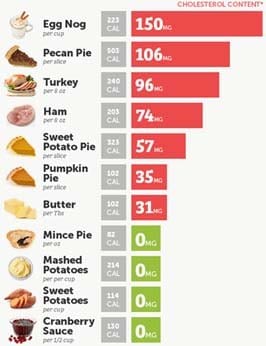
Holidays are great but be aware of what you eat
While certain cholesterol-rich foods are highly nutritious and beneficial to your health, others can be harmful.
Here are 4 high-cholesterol foods that can negatively impact your health.
8. Fried Foods
Fried foods — such as deep-fried meats and cheese sticks — are high-cholesterol and should be avoided whenever possible.
That’s because they’re loaded with calories and can contain trans fats, which increase heart disease risk and are detrimental to your health in many other ways.
Plus, high consumption of fried foods has been linked to an increased risk of heart disease, obesity, and diabetes.
9. Fast Food
Fast food consumption is a major risk factor for numerous chronic diseases including heart disease, diabetes, and obesity.
Those who frequently consume fast food tend to have higher cholesterol, more belly fat, higher levels of inflammation, and impaired blood sugar regulation.
Eating less processed food and cooking more meals at home is associated with lower body weight, less body fat, and reductions in heart disease risk factors like high LDL cholesterol.
10. Processed Meats
Processed meats, such as sausages, bacon, and hot dogs, are high-cholesterol foods that should be limited.
High consumption of processed meats has been linked to increased rates of heart disease and certain cancers like colon cancer.
A large review that included over 614,000 participants found that each additional 50-gram serving of processed meat per day was associated with a 42% higher risk of developing heart disease.
11. Desserts
Cookies, cakes, ice cream, pastries, and other sweets are unhealthy foods that tend to be high in cholesterol, as well as added sugars, unhealthy fats, and calories.
Frequently indulging in these foods can negatively impact overall health and lead to weight gain over time.
Research has linked added sugar intake to obesity, diabetes, heart disease, cognitive decline, and certain cancers
Plus, these foods are often devoid of the nutrients your body needs to thrive. These include vitamins, minerals, protein, and healthy fats.
Healthy Ways to Lower Your Cholesterol
Having high levels of “bad” LDL cholesterol can lead to cholesterol buildup in your blood vessels, which can increase your risk of developing heart disease.
Certain lifestyle and dietary changes can reduce LDL levels and create a more favorable LDL-to-HDL ratio.
Here are healthy, evidence-based ways to lower cholesterol levels:
- Eat more fiber: Research shows that consuming more fiber — especially soluble fiber found in fruits, beans, and oats — can help reduce LDL cholesterol levels.
- Increase physical activity: Becoming more physically active is an excellent way to lower cholesterol levels. High-intensity aerobic exercise seems to be the most effective way to reduce LDL.
- Lose weight: Dropping excess body weight is one of the best ways to lower cholesterol levels. It can reduce LDL while increasing HDL, which is optimal for health.
- Cut back on unhealthy habits: Quitting unhealthy habits like smoking can significantly reduce LDL levels. Smoking raises LDL cholesterol levels and greatly increases your risk of cancer, heart disease, and emphysema.
- Increase dietary omega-3s: Consuming more omega-3-rich foods like wild-caught salmon or taking omega-3 supplements like fish oil pills have been shown to reduce LDL and raise HDL levels.
- Eat more produce: Research shows that people who consume more fruits and vegetables have lower LDL cholesterol levels and are less likely to develop heart disease than those who eat less.
Herbal Alternative Remedies
Please Always Consult With Your Doctor First!!!
Astragalus:
Astragalus is an herb used to support the immune system in traditional Chinese medicine. It has antibacterial and anti-inflammatory properties. It’s considered to be an “adaptogen.” This means it’s believed to protect the body against various stresses.
Limited studies suggest that astragalus may have some benefits for your heart. But according to the National Center for Complementary and Integrative Health (NCCIH), high-quality clinical human trials are generally lacking. More research is needed to learn how astragalus may impact your cholesterol levels and overall heart health.
Hawthorn
Hawthorn is a shrub related to the rose. Its berries, leaves, and flowers have been used for heart problems since the time of the Roman Empire.
Some studies have found the plant to be an effective treatment for milder forms of heart failure. However, research results are conflicting, warns the NCCIH. There’s not enough scientific evidence to know if hawthorn is effective for other heart problems.
Flaxseed
Flaxseed comes from the flax plant. Both flaxseed and flaxseed oil contain high levels of alpha-linolenic acid (ALA). This is an omega-3 fatty acid that may help lower your risk of heart disease.
Research on the benefits of flaxseed for heart health has produced mixed results, reports the NCCIH. Some studies suggest that flaxseed preparations may help lower cholesterol, particularly among people with high cholesterol levels and postmenopausal women.
Fish with omega-3 fatty acids
Omega-3 fatty acids are also found in fish and fish oils. Salmon, tuna, lake trout, herring, sardines, and other fatty fish are especially rich sources.
According to the Mayo Clinic, experts have long believed that omega-3 fatty acids in fish help reduce the risk of dying from heart disease. More recent studies suggest that other nutrients in fish, or a combination of those nutrients and omega-3 fatty acids, may help protect your heart. Eating one or two servings of fatty fish per week may lower your chances of dying from a heart attack.
If you have heart disease, you may also benefit from taking omega-3 fatty acid supplements or eating other foods rich in omega-3 fatty acids. For example, walnuts, canola oil, and soybeans are good sources. However, the Mayo Clinic notes that the evidence is stronger for the benefits of eating fish with omega-3 fatty acids than taking supplements or eating other foods.
Garlic
Garlic is an edible bulb that’s been used as a cooking ingredient and medicine for thousands of years. It can be eaten raw or cooked. It’s also available in supplement form, as a capsule or tablet.
Some research suggests that garlic may help lower your blood pressure, reduce your blood cholesterol levels, and slow the progress of atherosclerosis, reports NCCIH. However, as with many alternative therapies, studies have yielded mixed results. For example, some studies have found that taking garlic for one to three months helps lower blood cholesterol levels. However, an NCCIH-funded study on the safety and effectiveness of three garlic preparations found no long-term effect on blood cholesterol.
Red yeast rice
Red yeast rice is a traditional Chinese medicine and cooking ingredient. It’s made by culturing red rice with yeast.
Some red yeast rice products contain substantial quantities of monacolin K, reports the NCCIH. This substance is chemically identical to the active ingredient in the cholesterol-lowering drug lovastatin. Red yeast rice products that contain this substance may help lower your blood cholesterol levels.
Other red yeast rice products contain little to no monacolin K, according to the NCCIH. Some also contain a contaminant called citrinin. This contaminant can cause kidney failure. In many cases, there’s no way for you to know which products contain monacolin K or citrinin. Therefore, it’s hard to tell which products will be effective or safe.
Plant sterol and stanol supplements
Plant sterols and stanols are substances found in many fruits, vegetables, nuts, seeds, grains, and other plants. Some processed foods are also fortified with plant sterols or stanols. For example, you may find fortified margarine, orange juice, or yogurt products.
Research suggests that plant sterols and stanols may help lower your risk of heart disease, reports the Cleveland Clinic. They help prevent your small intestine from absorbing cholesterol. This can lower “bad” LDL cholesterol levels in your blood.
Pros of natural remedies
- Most natural remedies can be accessed without a prescription.
- Some people find natural remedies helpful when used with their standard treatment plan.
Cons of natural remedies
-
- There’s no evidence that alternative or herbal remedies alone can lower cholesterol.
- Most natural remedies are unregulated, which means that some side effects may be unknown.
Diet and lifestyle changes
You can also adopt healthy lifestyle habits to help manage your blood cholesterol levels. For example:
-
-
- Stop smoking.
- Lose excess weight.
- Exercise most days of the week.
- Eat heart-healthy foods, including foods rich in soluble fiber and omega-3 fatty acids.
- Limit your consumption of foods high in saturated fats. For example, substitute olive oil for butter.
- Eliminate trans fats from your diet.
- Drink alcohol in moderation.
- Take steps to reduce stress.
-
A great site for more information:
Michael.
Comments are welcome
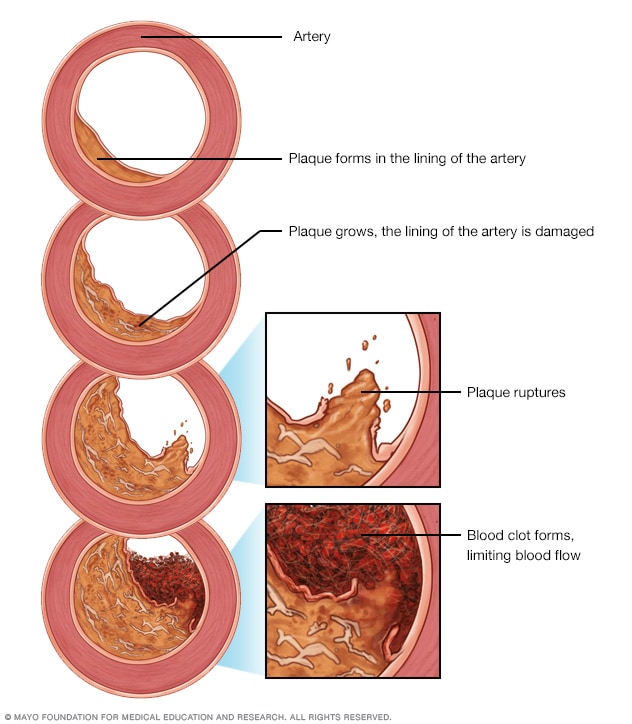
Thanks for sharing all of this great information on cholesterol — the illustrations were particularly helpful in order to understand what is going on behind the scenes when hearing the term “high cholesterol”. It’s something I’ve kept a close watch on in recent years and I have definitely noticed that diet will make a huge difference in my levels. It was very interesting to watch good cholesterol go up and bad cholesterol go down when I was having a bulletproof coffee every morning. Thanks for sharing all of this helpful health info!
Hi Aly,
Thank you for your comments. I am so glad you are cholesterol aware and maintaining a healthy level. I hope my post has helped in some way.
Best wishes,
Michael
Due to my age, this is not something I have had to worry about just yet. However, I know how serious these issues can become and my age will be creeping up on me before I know it. I used to be a very healthy individual but lately, I have been slacking tremendously with my poor diet. Thankfully, I just lost 50 pounds last year so I am no longer “obese” but I am trying to be very careful not to get back to that point again.
I am not a smoker so at least I have that on my side… your post is very eye-opening and is not something to be taken lightly at any point in your life. My unhealthy habits now will haunt me later in life. Additionally, diabetes has been known to run in my family with unhealthy eating habits and I am sure I will not be an exception to this if I don’t start taking care of myself again.
Thanks for sharing!
Hi Kara,
Thank you for your comments. First of all congratulations on losing that 50 lbs. Kara, age really is not a factor in bad high cholesterol. Glad to hear you are not a smoker.
It is never too late to change past unhealthy habits. You have already started doing that and that is great. Please do not think you may be more susceptible to diabetes. I do have a post on Diabetes 2, perhaps you may find a few things there to re-assure you.
Sunshine, exercise, diet, sleep are very essential, they are listed as the 4 out of 6 of the best free doctors. Use them.
Best wishes,
Michael
Some people might not know that we actually need some cholesterol in order to build healthy cells, and I must admit I am one of those people. I have always heard that cholesterol is bad no matter what, so it’s good to know that some is actually needed. It’s also good to know that there are treatments out there. I know some people who struggle with obesity sadly. Knowing which foods to eat and how to treat cholesterol can be invaluable and life-saving information. I will definitely share your post with them in hopes that it will provide some enlightenment. Thanks for great insights into cholesterol and keep up the good work!
Hi Pentrental,
Thank you for your comments. You are absolutely right when you say we need some cholesterol in order to build healthy cells. That is why we have two types:
LDL (low-density lipoprotein cholesterol, also called “bad” cholesterol)HDL (high-density lipoprotein cholesterol, also called “good” cholesterol)
The wrong type of high cholesterol has been claiming too many lives. This can be prevented through proper diet, exercise and like you mentioned weight maintenance.
Best wishes,
Michael